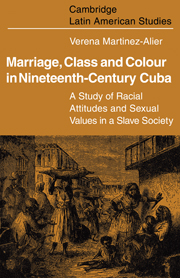 Marriage, Class and Colour in Nineteenth Century Cuba
Marriage, Class and Colour in Nineteenth Century Cuba Book contents
- Frontmatter
- Contents
- Preface
- List of abbreviations
- INTRODUCTION
- PART ONE INTERRACIAL MARRIAGE
- 1 Intermarriage and family honour
- 2 Intermarriage and politics
- 3 Intermarriage and Catholic doctrine
- 4 The white man's view
- 5 Colour as a symbol of social status
- 6 Intraracial marriage
- PART TWO HONOUR AND CLASS
- Appendix: Three Cuban genealogies
- Notes to the text
- Bibliography
- Index
6 - Intraracial marriage
Published online by Cambridge University Press: 09 October 2009
- Frontmatter
- Contents
- Preface
- List of abbreviations
- INTRODUCTION
- PART ONE INTERRACIAL MARRIAGE
- 1 Intermarriage and family honour
- 2 Intermarriage and politics
- 3 Intermarriage and Catholic doctrine
- 4 The white man's view
- 5 Colour as a symbol of social status
- 6 Intraracial marriage
- PART TWO HONOUR AND CLASS
- Appendix: Three Cuban genealogies
- Notes to the text
- Bibliography
- Index
Summary
marriage between whites
The issue of slavery deeply divided opinion within the white community. For political and economic reasons some sectors favoured interracial marriage, but many abolitionists would probably have thought twice about marrying their daughters to a coloured person. Even the common man prided himself on his purity of blood, his sole mark of distinction. One should not think, however, that race obliterated any other criteria of status definition among whites themselves. Differential socio-economic status within their own ranks played a role with regard to marriage, and gave grounds for parental opposition. Opposition to marriage among whites was often motivated by such criteria as birth, wealth, occupation and religion. There was clearly nothing very specific to Cuba in all this as compared, for instance, with Spain and other European countries at the time, where possibly the opportunities for individual advancement were more limited than in Cuba. More characteristic of Cuba, however, was the preoccupation over race which reinforced the concern over ascription.
The stated aim of the 1776 Royal Pragmatic on marriage was to prevent any marriages that gravely offended the family's honour and threatened the State. No instructions were issued, however, neither with the Pragmatic nor in later legislation, on the terms on which an intraracial marriage could be deemed unequal and therefore objectionable. Canon law established a number of specific impediments to marriage such as consanguineous, affinal and ritual kinship. Social impediments were left to custom, and became explicit only when parents, making use of their legal rights, opposed a marriage by their minor children before the civil authorities.
- Type
- Chapter
- Information
- Marriage, Class and Colour in Nineteenth Century CubaA Study of Racial Attitudes and Sexual Values in a Slave Society, pp. 82 - 100Publisher: Cambridge University PressPrint publication year: 1974


